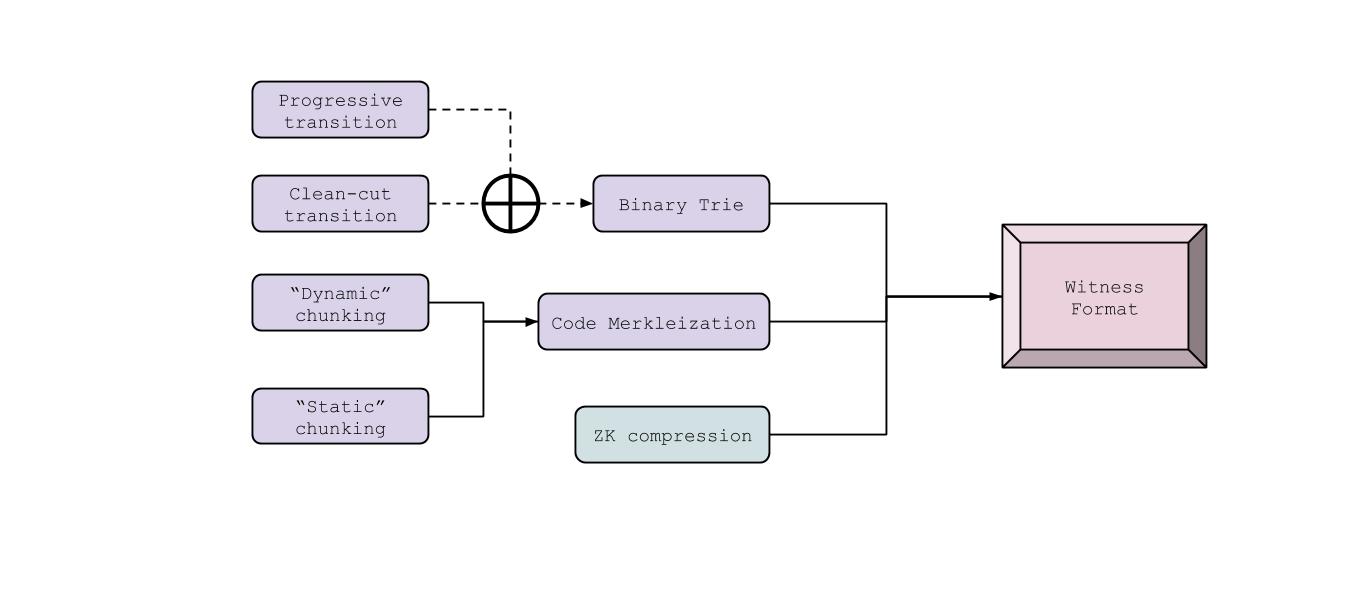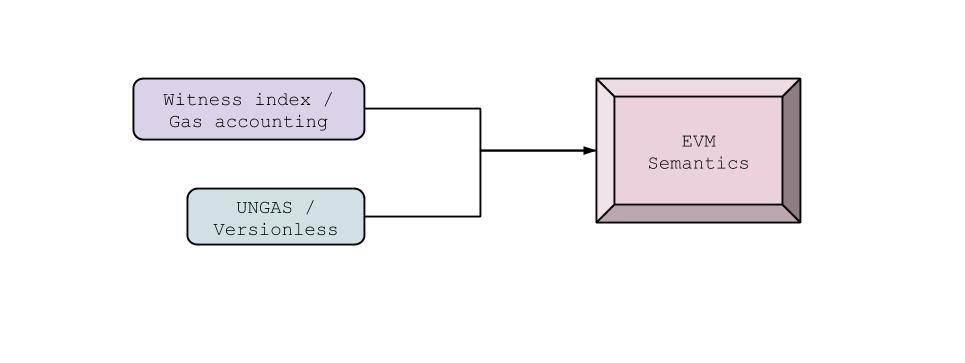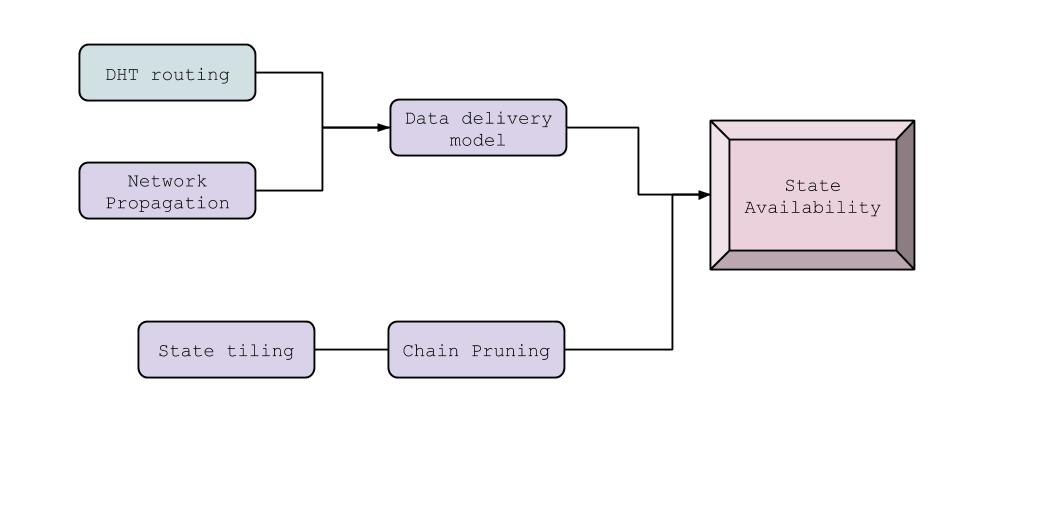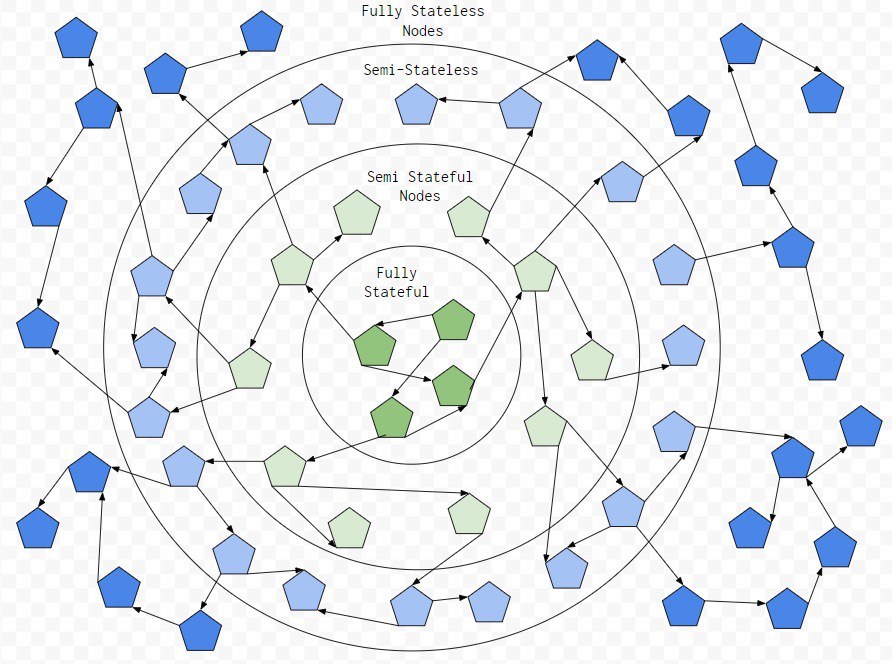I began to jot down a publish that detailed a “roadmap” for Ethereum 1.x analysis and the trail to stateless Ethereum, and realized that it isn’t really a roadmap in any respect —— no less than not within the sense we’re used to seeing from one thing like a product or firm. The 1.x workforce, though working towards a standard aim, is an eclectic assortment of builders and researchers independently tackling intricately associated subjects. Consequently, there is no such thing as a “official” roadmap to talk of. It isn’t full chaos although! There may be an understood “order of operations”; some issues should occur earlier than others, sure options are mutually unique, and different work is likely to be helpful however non-essential.
So what’s a greater metaphor for the best way we get to stateless Ethereum, if not a roadmap? It took me just a little bit, however I believe I’ve an excellent one: Stateless Ethereum is the ‘full spec’ in a tech tree.
Some readers may instantly perceive this analogy. If you happen to “get it”, be happy to skip the subsequent few paragraphs. However in the event you’re not like me and do not ordinarily take into consideration the world by way of video video games: A tech tree is a standard mechanic in gaming that enables gamers to unlock and improve new spells, applied sciences, or abilities which are sorted right into a free hierarchy or tree construction.
Normally there may be some type of XP (expertise factors) that may be “spent” to amass parts within the tree (‘spec’), which in flip unlock extra superior parts. Generally you have to purchase two un-related fundamental parts to entry a 3rd extra superior one; typically unlocking one fundamental talent opens up a number of new decisions for the subsequent improve. Half the enjoyable as a participant is selecting the best path within the tech trie that matches your capacity, targets, and preferences (do you purpose for full spec in Warrior, Thief, or Mage?).
That is, in surprisingly correct phrases, what we’ve within the 1.x analysis room: A free hierarchy of technical topics to work on, with restricted time/experience to put money into researching, implementing, and testing. Simply as in an excellent RPG, expertise factors are finite: there’s solely a lot {that a} handful of succesful and motivated people can accomplish in a yr or two. Relying on the necessities of supply, it is likely to be clever to carry off on extra formidable or summary upgrades in favor of a extra direct path to the ultimate spec. Everyone seems to be aiming for a similar finish aim, however the path taken to get there’ll rely on which options find yourself being totally researched and employed.
Okay, so I will current my tough drawing of the tree, discuss just a little about the way it’s organized, after which briefly go into a proof of every improve and the way it pertains to the entire. The ultimate “full-spec” improve within the tech tree is “Stateless Ethereum”. That’s to say, a totally functioning Ethereum mainnet that helps full-state, partial-state, and zero-state nodes; that effectively and reliably passes round witnesses and state info; and that’s in precept able to proceed scaling till the bridge to Eth2.0 is constructed and able to onboard the legacy chain.

Observe: As I mentioned simply above, this is not an ‘official’ scheme of labor. It is my finest effort at collating and organizing the important thing options, milestones, and selections that the 1x working group should choose with the intention to make Stateless Ethereum a actuality. Suggestions is welcome, and up to date/revised variations of this plan shall be inevitable as analysis continues.
It is best to learn the diagram from left to proper: purple parts offered on the left aspect are ‘elementary’ and have to be developed or determined upon earlier than subsequent enhancements additional proper. Components with a greenish hue are coloured so to point that they’re in some sense “bonus” gadgets — fascinating although not strictly mandatory for transition, and possibly much less concretely understood within the scope of analysis. The bigger pink shapes characterize important milestones for Stateless Ethereum. All 4 main milestones have to be “unlocked” earlier than a full-scale transition to Stateless Ethereum may be enacted.
The Witness Format
There was a number of speak about witnesses within the context of stateless Ethereum, so it ought to come as no shock that the primary main milestone that I will deliver up is a finalized witness format. This implies deciding with some certainty the construction of the state trie and accompanying witnesses. The creation of a specification or reference implementation could possibly be considered the purpose at which ETH 1.x analysis “ranges up”; coalescing round a brand new illustration of state will assist to outline and focus the work wanted to be carried out to achieve different milestones.

Binary Trie (or “trie, trie once more”)
Switching Ethereum’s state to a Binary Trie construction is essential to getting witness sizes sufficiently small to be gossiped across the community with out working into bandwidth/latency points. As outlined within the last research call, attending to a Binary Trie would require a dedication to one in every of two mutually unique methods:
-
Progressive. Like the Ship of Theseus, the present hexary state trie woud be reworked piece-by-piece over an extended time period. Any transaction or EVM execution touching elements of state would by this technique mechanically encode adjustments to state into the brand new binary type. This means the adoption of a ‘hybrid’ trie construction that may go away dormant elements of state of their present hexary illustration. The method would successfully by no means full, and can be complicated for shopper builders to implement, however would for probably the most half insulate customers and higher-layer builders from the adjustments taking place underneath the hood in layer 0.
-
Clear-cut. Maybe extra aligned with the importance of the underlying trie change, a clean-cut transition technique would outline an express time-line of transition over a number of exhausting forks, compute a recent binary trie illustration of the state at the moment, then keep on in binary type as soon as the brand new state has been computed. Though extra simple from an implementation perspective, a clean-cut requires coordination from all node operators, and would nearly actually entail some (restricted) disruption to the community, affecting developer and consumer expertise throughout the transition. Then again, the method may present some helpful insights for planning the extra distant transition to Eth2.
Whatever the transition technique chosen, a binary trie is the idea for the witness construction, i.e. the order and hierarchy of hashes that make up the state trie. With out additional optimization, tough calculations (January 2020) put witness sizes within the ballpark of ~300-1,400 kB, down from ~800-3,400 kB within the hexary trie construction.
Code Chunking (merkleization)
One main element of a witness is accompanying code. With out code chunking, A transaction that contained a contract name would require the complete bytecode of that contract with the intention to confirm its codeHash. That could possibly be a number of information, relying on the contract. Code ‘merkleization’ is a technique of splitting up contract bytecode in order that solely the portion of the code known as is required to generate and confirm a witness for the transaction. That is one strategy of dramatically lowering the common dimension of witnesses. There are two methods to separate up contract code, and for the second it isn’t clear the 2 are mutually unique.
- “Static” chunking. Breaking contract code up into fastened sizes on the order of 32 bytes. For the merkleized code to run accurately, static chunks additionally would want to incorporate some additional meta-data together with every chunk.
- “Dynamic” chunking. Breaking contract code up into chunks based mostly on the content material of the code itself, cleaving at particular directions (JUMPDEST) contained therein.
At first blush, the “static” method in code chunking appears preferable to keep away from leaky abstractions, i.e. to stop the content material of the merkleized code from affecting the lower-level chunking, as may occur within the “dynamic” case. That mentioned, each choices have but to be totally examined and due to this fact each stay in consideration.
ZK witness compression
About 70% of a witness is hashes. It is likely to be attainable to make use of a ZK-STARK proofing approach to compress and confirm these intermediate hashes. As with a number of zero-knowledge stuff nowadays, precisely how that may work, and even that it might work in any respect just isn’t well-defined or simply answered. So that is in some sense a side-quest, or non-essential improve to the principle tech growth tree.
EVM Semantics
We have touched briefly on “leaky abstraction” avoidance, and it’s most related for this milestone, so I will take just a little detour right here to elucidate why the idea is vital. The EVM is an abstracted element a part of the larger Ethereum protocol. In idea, particulars about what’s going on contained in the EVM should not have any impact in any respect on how the bigger system behaves, and adjustments to the system outdoors of the abstraction should not have any impact in any respect on something inside it.
In actuality, nonetheless, there are particular features of the protocol that do straight have an effect on issues contained in the EVM. These manifest plainly in gasoline prices. A wise contract (contained in the EVM abstraction) has uncovered to it, amongst different issues, gasoline prices of assorted stack operations (outdoors the EVM abstraction) by the GAS opcode. A change in gasoline scheduling may straight have an effect on the efficiency of sure contracts, nevertheless it is dependent upon the context and the way the contract makes use of the knowledge to which it has entry.
Due to the ‘leaks’, adjustments to gasoline scheduling and EVM execution should be made rigorously, as they might have unintended results on sensible contracts. That is only a actuality that have to be handled; it’s extremely troublesome to design methods with zero abstraction leakage, and in any occasion the 1.x researchers haven’t got the posh of redesigning something from the bottom up — They should work inside at the moment’s Ethereum protocol, which is only a wee bit leaky within the ol’ digital state machine abstraction.
Returning to the principle matter: The introduction of witnesses will require adjustments to gasoline scheduling. Witnesses should be generated and propagated throughout the community, and that exercise must be accounted for in EVM operations. The subjects tied to this milestone should do with what these prices and incentives are, how they’re estimated, and the way they are going to be applied with minimal influence on larger layers.

Witness Indexing / Gasoline accounting
There may be probably way more nuance to this part than can fairly slot in a number of sentences; I am certain we’ll dive a bit deeper at a later date. For now, perceive that each transaction shall be liable for a small a part of the complete block’s witness. Producing a block’s witness includes some computation that shall be carried out by the block’s miner, and due to this fact might want to have an related gasoline price, paid for by the transaction’s sender.
As a result of a number of transactions may contact the identical a part of the state, it isn’t clear one of the simplest ways to estimate the gasoline prices for witness manufacturing on the level of transaction broadcast. If transaction house owners pay the complete price of witness manufacturing, we are able to think about conditions by which the identical a part of a block witness is likely to be paid for a lot of instances over by ‘overlapping’ transactions. This is not clearly a foul factor, thoughts you, nevertheless it introduces actual adjustments to gasoline incentives that should be higher understood.
Regardless of the related gasoline prices are, the witnesses themselves might want to develop into part of the Ethereum protocol, and certain might want to integrated as an ordinary a part of every block, maybe with one thing as simple as a witnessHash included in every block header.
UNGAS / Versionless Ethereum
This can be a class of upgrades largely orthogonal to Stateless Ethereum that should do with gasoline prices within the EVM, and patching up these abstraction leaks I discussed. UNGAS is brief for “unobservable gasoline”, and it’s a modification that may explicitly disallow contracts from utilizing the GAS opcode, to ban any assumptions about gasoline price from being made by sensible contract builders. UNGAS is a part of quite a lot of solutions from the Ethereum core paper to patch up a few of these leaks, making all future adjustments to gasoline scheduling simpler to implement, together with and particularly adjustments associated to witnesses and Stateless Ethereum.
State Availability
Stateless Ethereum just isn’t going to eliminate state completely. Somewhat, it is going to make state an optionally available factor, permitting shoppers a point of freedom with regard to how a lot state they maintain observe of and compute themselves. The complete state due to this fact have to be made obtainable someplace, in order that nodes seeking to obtain a part of the entire state could accomplish that.
In some sense, current paradigms like quick sync already present for this performance. However the introduction of zero-state and partial-state nodes complicates issues for brand new nodes getting up to the mark. Proper now, a brand new node can anticipate to obtain the state from any wholesome friends it connects to, as a result of all nodes make a copy of the present state. However that assumption goes out the window if a few of friends are doubtlessly zero-state or partial-state nodes.
The pre-requisites for this milestone should do with the methods nodes sign to one another what items of state they’ve, and the strategies of delivering these items reliably over a continually altering peer-to-peer community.

Community Propagation Guidelines
This diagram beneath represents a hypothetical community topology that would exist in stateless Ethereum. In such a community, nodes will want to have the ability to place themselves based on what elements of state they wish to maintain, if any.

Enhancements comparable to EIP #2465 fall into the overall class of community propagation guidelines: New message varieties within the community protocol that present extra details about what info nodes have, and outline how that info is handed to different nodes in doubtlessly awkward or restricted community topologies.
Knowledge Supply Mannequin / DHT routing
If enhancements just like the message varieties described above are accepted and applied, nodes will be capable of simply inform what elements of state are held by linked friends. What if not one of the linked friends have a wanted piece of state?
Knowledge supply is a little bit of an open-ended downside with many potential options. We might think about turning to extra ‘mainstream’ options, making some or the entire state obtainable over HTTP request from a cloud server. A extra formidable resolution can be to undertake options from associated peer-to-peer information supply schemes, permitting requests for items of state to be proxied by linked friends, discovering their appropriate locations by a Distributed Hash Table. The 2 extremes aren’t inherently incompatible; Porque no los dos?
State tiling
One method to enhancing state distribution is to interrupt the complete state into extra manageable items (tiles), saved in a networked cache that may present state to nodes within the community, thus lightening the burden on the complete nodes offering state. The thought is that even with comparatively massive tile sizes, it’s probably that among the tiles would stay un-changed from block to dam.
The geth workforce has carried out some experiments which counsel state tiling is possible for enhancing the supply of state snapshots.
Chain pruning
Much has been written on chain pruning already, so a extra detailed rationalization just isn’t mandatory. It’s price explicitly stating, nonetheless, that full nodes can safely prune historic information comparable to transaction receipts, logs, and historic blocks provided that historic state snapeshots may be made available to new full nodes, by one thing like state tiling and/or a DHT routing scheme.
Community Protocol Spec
Ultimately, the whole image of Stateless Ethereum is coming into focus. The three milestones of Witness Format, EVM Semantics, and State Availability collectively allow an entire description of a Community Protocol Specification: The well-defined upgrades that must be coded into each shopper implementation, and deployed throughout the subsequent exhausting fork to deliver the community right into a stateless paradigm.
We have coated a number of floor on this article, however there are nonetheless a number of odd and ends from the diagram that must be defined:
Formal Stateless Specification
On the finish of the day, it isn’t a requirement that the whole stateless protocol be formally outlined. It’s believable {that a} reference implementation be coded out and used as the idea for all shoppers to re-implement. However there are plain advantages to making a “formalized” specification for witnesses and stateless shoppers. This is able to be basically an extension or appendix that would slot in the Ethereum Yellow Paper, detailing in exact language the anticipated habits of an Ethereum stateless shopper implementation.
Beam Sync, Pink Queen’s sync, and different state sync optimizations
Sync methods aren’t main to the community protocol, however as a substitute are implementation particulars that have an effect on how performant nodes are in enacting the protocol. Beam sync and Pink Queen’s sync are associated methods for build up a neighborhood copy of state from witnesses. Some effort must be invested in enhancing these methods and adapting them for the ultimate ‘model’ of the community protocol, when that’s determined and applied.
For now, they’re being left as ‘bonus’ gadgets within the tech tree, as a result of they are often developed in isolation of different points, and since particulars of their implementation rely on extra elementary decisions like witness format. Its price noting that these extra-protocol subjects are, by advantage of their independence from ‘core’ adjustments, an excellent car for implementing and testing the extra elementary enhancements on the left aspect of the tree.
Wrapping up
Nicely, that was fairly an extended journey! I hope that the subjects and milestones, and basic thought of the “tech tree” is useful in organizing the scope of “Stateless Ethereum” analysis.
The construction of this tree is one thing I hope to maintain up to date as issues progress. As I mentioned earlier than, it isn’t an ‘official’ or ‘closing’ scope of labor, it is simply probably the most correct sketch we’ve in the meanwhile. Please do attain out in case you have solutions on find out how to enhance or amend it.
As all the time, in case you have questions, requests for brand new subjects, or wish to take part in stateless Ethereum analysis, come introduce your self on ethresear.ch, and/or attain out to @gichiba or @JHancock on twitter.
